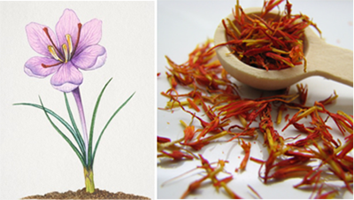 In texts of Ayurveda the herb Crocus Sativus or kumkuma or saffron is grouped under “Varnya” gana. Varnya means the one which imparts fairness and glow to skin.
In texts of Ayurveda the herb Crocus Sativus or kumkuma or saffron is grouped under “Varnya” gana. Varnya means the one which imparts fairness and glow to skin.
Saffron is one of the costliest spices used in Ayurveda, Unani and Chinese medicinal preparations. It is used extensively in European, North African, and Asian cuisines as a seasoning and coloring agent. The history of this plant’s origin and cultivation can be traced back to 3000 years in the region of Central Asia.
The saffron plant is flowering perennial plant. Purple colored flower of this plant bears three stigmas. The plucked and dried stigmas are used in cooking, medicine preparations and beauty products. Saffron contains a carotenoid called crocin which imparts bright golden yellow color to dishes.
Ayurveda Qualities of Saffron or Kumkuma
According ayurveda pharmacology, saffron is bitter to taste and increases body fire. It balances tridoshas (vata, pitta and kapha).
Ayurveda Medicinal Properties of Saffron
- Effect on skin: .It helps to reduce dark pigments, dark circles under eyes, acne and pimple. It helps to increase fairness and glow of skin.
- Effect On Central Nervous System: Saffron is used as an active ingredient in ayurveda preparations for diseases of central nervous system.
- In Rheumatoid arthritis: It is very effective in Rheumatoid arthritis.
- Effect On Digestive System: Kumkuma or saffron helps to increase appetite .It also reduces indigestion, diarrhea, vomiting and acidity
- Effect on Circulatory system: Saffron acts as a cardiac tonic and is used to treat diseases which originate from vitiation of blood.
- Effect on Excretory system: It helps in easy flow of urine and hence used in retention of urine.
- Effect on reproductive system:
- Male reproductive system: Saffron rejuvenates male reproductive system. This property is used in ayurveda to treat conditions like erectile dysfunction, premature ejaculation, low sperm count and low sperm motility.
- Female reproductive system: Saffron helps to ease the menstrual flow and acts as antispasmodic. Hence it is used in dysmenorrhea, primary amenorrhea and to ease delivery of baby.
Effect on whole body: These beautiful red stigmas help to rejuvenate body and act as “rasayana”. They boost body immunity and increase energy level.
Home Remedies with Saffron
- Make a paste of sandal wood and saffron. Dilute this with little water and apply it as face pack. This helps to reduce acne, pimples, dark circles, dark pigments and increase fairness and glow of skin.
- Saffron paste when applied on wound accelerates healing process.
- When sandal wood and saffron paste mixture is applied on forehead it helps to reduce fever and head ache.
- A mixture of rose water and finely ground saffron instilled in eyes help to strengthen the vision.
- Fry 4-5 almonds in ghee. Grind these almonds with saffron and milk to make a fine paste. Mix this paste to a cup of milk to get rich, thick golden yellow kesar badam milk. Consuming kesar badam milk at night helps to rejuvenate male and female reproductive system. This helps men who are suffering with erectile dysfunction, low sperm count, low sperm motility and premature ejaculation.
- Saffron has to be administered in pregnant women from third trimester. (7th month). Around 5-6 stigmas of saffron should be ground with milk and later mixed to a cup of milk. This milk has to be consumed at night.
Precaution: Saffron should not be administered in early pregnancy as it may cause abortion.
Image (c) Gettyimages.com
 In texts of Ayurveda the herb Crocus Sativus or kumkuma or saffron is grouped under “Varnya” gana. Varnya means the one which imparts fairness and glow to skin.
In texts of Ayurveda the herb Crocus Sativus or kumkuma or saffron is grouped under “Varnya” gana. Varnya means the one which imparts fairness and glow to skin.